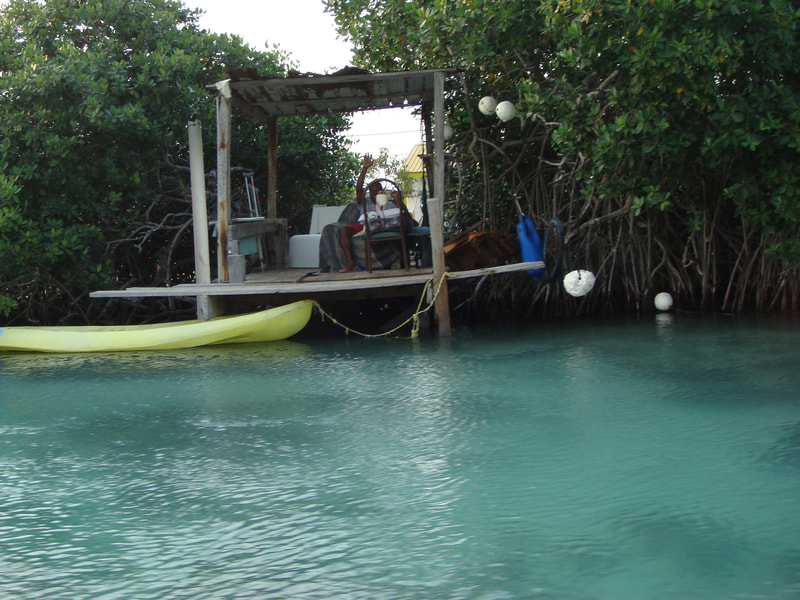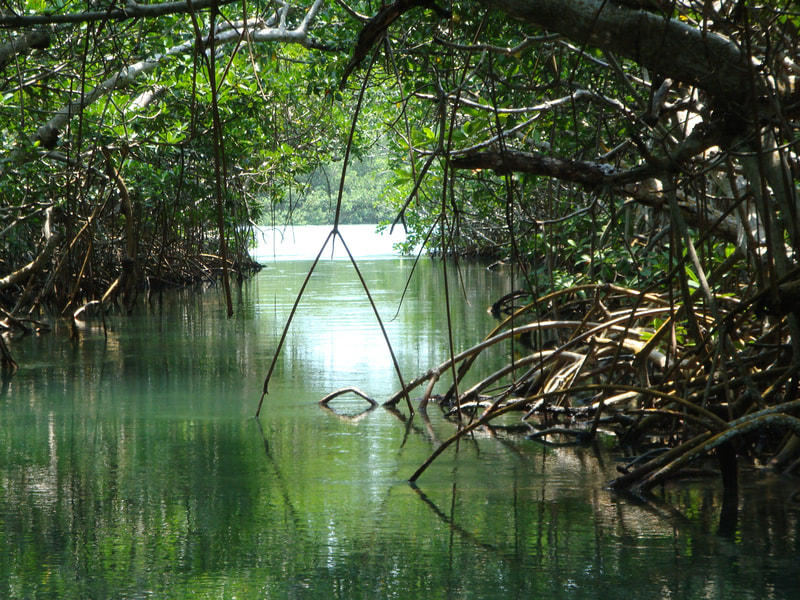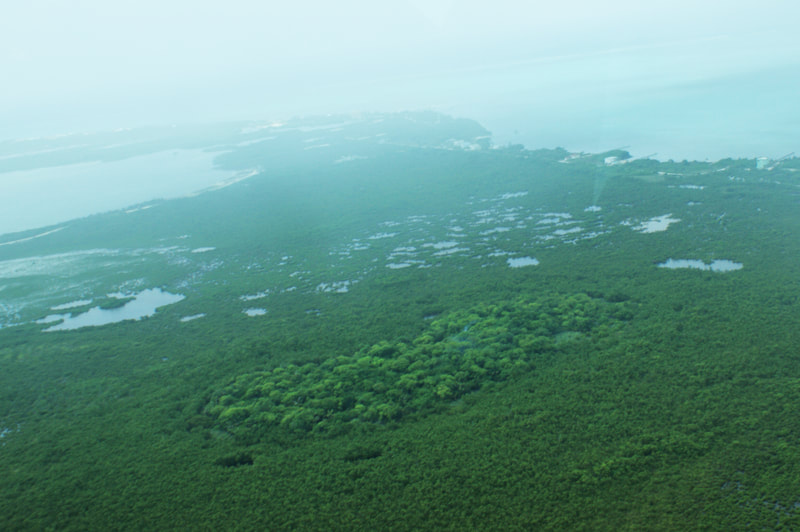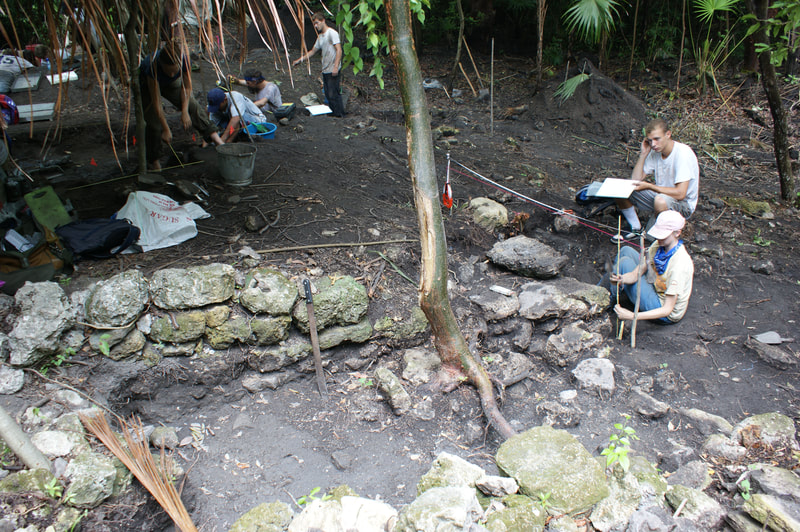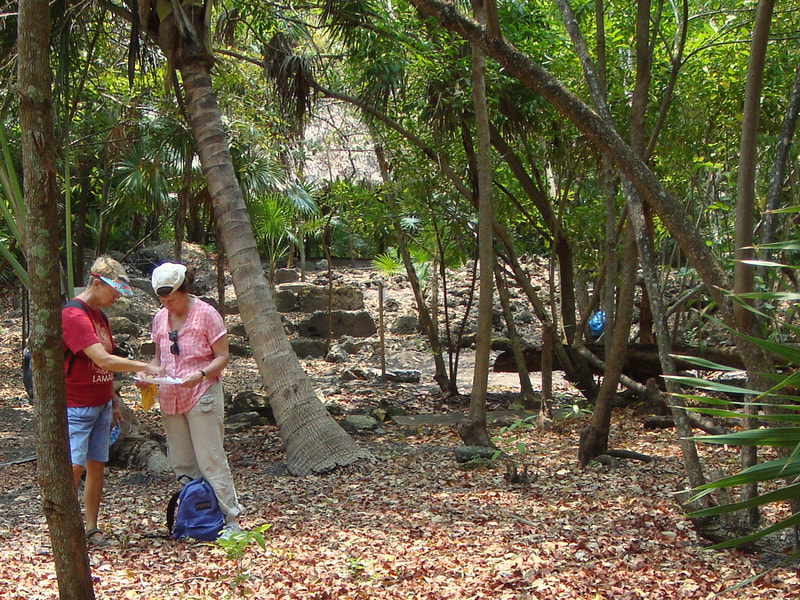ANCIENT MAYA ON AMBERGRIS CAYE
Excavations directed by Elizabeth Graham and David Pendergast began on Ambergris Caye, specifically at the site of Marco Gonzalez, in 1986. The results of the preliminary investigations have been reported in the Journal of Field Archaeology 16:1-16. Work continued at Marco Gonzalez in 1990, and later by Elizabeth Graham and Scott Simmons from 2010 to 2012. From 1991 to 1993 small-scale excavations were carried out in the town of San Pedro, and also at Santa Cruz, on the island's leeward side, to reveal something about the chronology of settlement and environmental change. Graham and Pendergast's work on the southern part of Ambergris Caye complements the archaeological excavations carried out by Thomas Guderjan, James Garber, and Herman Smith at sites on the northern part of the caye, and reported in Maya Maritime Trade, Settlement, and Populations on Ambergris Caye, Belize (edited by T. Guderjan and J. Garber, 1995). Tom Guderjan has also written a booklet on the history of the archaeology of Ambergris Caye, and this is available at many bookstores and shops in Belize.
Marco Gonzalez first saw intensive use during the Protoclassic and Early Classic periods (ca. A.D. 1-250), but scattered sherds indicate that the area may have been utilized as early as the Late Preclassic period (about 100 B.C.). The presence of huge numbers of sherds from standardized vessels thought to have been used to make salt cakes indicates that islanders focused largely on the shipment of salt during the Late Classic period (ca. A.D. 600-800) but that this tailed off during the time of the Maya collapse, and was replaced by renewed interest in wider-ranging trade. Most of the 49 buildings identified at Marco Gonzalez were either built in or modified in the Early and Middle Postclassic periods (A.D. 900-1300). Less dense occupation continued through the Late Postclassic and early Historic periods as indicated by the ceramics recovered from residential remains, surface scatter, and from offerings in a late addition to the stair of Str. 12, a probable residential building.
Santa Cruz also seems to have supported salt-making and distributing during the Late Classic, and to have seen substantial expansion and construction during the Early Postclassic. There is more evidence of Late Postclassic residences at Santa Cruz than at Marco Gonzalez, and numerous fruit trees indicate that the area has been used in one form or another right down to the present day.
Excavations in San Pedro itself turned up remains from a variety of periods as early as the Early Classic, although it appears that Late Postclassic occupation was the most intensive. The indications are that San Pedro was indeed a population centre during the Late Postclassic and early Historic periods. Historic remains cluster around the Sands Hotel, Martha's Store, the Alijua Building, and the lots adjoining these areas. In 1992, Pendergast discovered a number of well-preserved burials below house floors on the Sands property, and further remains of residential activity were discovered in 1993, although the small areas opened made a full assessment of occupation impossible. The stratigraphy and character of sediments on the Sands property suggested to geologist S.J. Mazzullo from Wichita State University that the island had, prior to the Late Postclassic period, been crossed by a channel in the zone that is now considered the town's centre. Further excavation is necessary before this can be confirmed. Of the artifacts recovered, the most complete and best preserved ceramics come from Marco Gonzalez. A good example is the whistle figurine of a musician. The excellent preservation of burials means that a great deal can be learned about the diet and health of the first San Pedranos. Studies were carried out by Dr. Christine White of the University of Western Ontario and her students. Sherds from Spanish Colonial olive jars are evidence of the early Spanish contact, and bottles and ceramics from the British and modern periods abound. Not surprisingly, the faunal remains indicate that the island supported a lively fishing and shellfishing industry from at least 50 B.C. onward. Continuing environmental studies by Elizabeth Graham and colleagues in 2013 and 2014 focused on the impact of Maya occupation on soil-forming processes and vegetational succession, and the dynamics of environmental impact from ancient Maya salt processing. Garbage and waste management studies were undertaken in order to assess modern cycling of nutrients and soil-building efforts.
PUBLICATIONS ON SAN PEDRO MAYA SITES
[PDF] 2019 Mayfield, Tracie, and Scott E. Simmons
From the Canopy to the Caye: Two of Britain’s Colonial Ventures in Nineteenth-Century Belize. In Archaeologies of the British in Latin America, pp. 121-156. Springer, Cham, 2019.
[PDF] 2019 Simmons, Scott E. and Tracie Mayfield
Preliminary Report of the 2017 Field Season at the San Pedro site, Ambergris Caye, Belize, 2019
ABSTRACT: The following report presents a summary of the preliminary findings of 2017 archaeological investigations of the San Pedro site, located in the southern portion of Ambergris Caye, Belize. Four trenches were excavated on the Hostel la Vista (now Parham Plaza Hotel) property in June 2017 as part of an archaeological field school offered by the University of North Carolina Wilmington in advance of landscape modifications on the grounds of the hotel. Portions of the San Pedro site had been excavated previously in the early 1990s by Drs. David Pendergast and Elizabeth Graham, who found both Maya and early Spanish and British colonial domestic material. Archaeological investigations in 2017 confirmed the presence of a Late Postclassic Maya community focused heavily on marine resource exploitation as well as early Spanish and British colonial occupations. Probable Maya flooring remains as well as a single Maya burial were encountered, and British-era and later features were identified as well. Investigations in 2017 at the San Pedro site added substantially to the body of Late Postclassic Period Maya material remains available for study. Preliminary analyses of both artifacts and ecofacts reveal that the Late Postclassic San Pedro Maya enjoyed strong economic and social relationships with other Maya communities on Ambergris Caye, the mainland of northern Belize, and beyond.
[PDF] 2018 Tracie Mayfield & Scott E. Simmons
Why the Present Matters: The Importance of Community Outreach and Public Engagement in Archaeology, Anthropology Now, 10:1, 25-39, DOI: 10.1080/19428200.2018.1439145
[PDF] 2018 Simmons, Scott E., Tracie Mayfield, William Stemp, and James Aimers
The Maya of Ambergris Caye and their Neighbors. In Research Reports in Belizean Archaeology, 2018.
[PDF] 2016 Simmons, Scott E. and Elizabeth Graham. Maya Coastal Adaptations in Classic and Postclassic Times on Ambergris Caye, Belize. In Trading Spaces: The Archaeology of Interaction, Migration and Exchange. Proceedings of the 46th Annual Chacmool Archaeology Conference, edited by Margaret Patton and Jessica Manion, pp. 167-180. Chacmool Archaeology Association, University of Calgary, Calgary, Alberta, Canada.
[PDF] 2011 Stemp, James W., Elizabeth Graham & Jessica Goulet. Coastal Maya Obsidian Trade in the Late Postclassic to Early Colonial Period: The View From San Pedro, Ambergris Caye, Belize, The Journal of Island and Coastal Archaeology, 6:1, 134-154, DOI: 10.1080/15564894.2010.487366
[PDF] 1987-1994 Graham, Elizabeth and David Pendergast. Ambergris Caye Royal Ontario Museum Archaeological Newsletters (Marco Gonzalez and San Pedro Maya sites).
2003 Douglas M. Weinberg, Elizabeth Graham and David M. Pendergast. Salvage Excavation of the Alamilla/Gomez Property, San Pedro, Ambergris Caye, Belize. FAMSI (Foundation for the Advancement of Mesoamerican Studies, Inc.) http://www.famsi.org/reports/01006/index.html
[PDF]1995 Guderjan, Thomas H. “Maya Settlement and Trade on Ambergris Caye, Belize.” Ancient Mesoamerica 6: 147–59. https://doi.org/10.1017/S0956536100002157.
1995 Guderjan, Thomas H. and James F. Garber, eds. Maya Maritime Trade, Settlement, and Populations on Ambergris Caye, Belize. Lancaster, CA: Labyrinthos.
Excavations directed by Elizabeth Graham and David Pendergast began on Ambergris Caye, specifically at the site of Marco Gonzalez, in 1986. The results of the preliminary investigations have been reported in the Journal of Field Archaeology 16:1-16. Work continued at Marco Gonzalez in 1990, and later by Elizabeth Graham and Scott Simmons from 2010 to 2012. From 1991 to 1993 small-scale excavations were carried out in the town of San Pedro, and also at Santa Cruz, on the island's leeward side, to reveal something about the chronology of settlement and environmental change. Graham and Pendergast's work on the southern part of Ambergris Caye complements the archaeological excavations carried out by Thomas Guderjan, James Garber, and Herman Smith at sites on the northern part of the caye, and reported in Maya Maritime Trade, Settlement, and Populations on Ambergris Caye, Belize (edited by T. Guderjan and J. Garber, 1995). Tom Guderjan has also written a booklet on the history of the archaeology of Ambergris Caye, and this is available at many bookstores and shops in Belize.
Marco Gonzalez first saw intensive use during the Protoclassic and Early Classic periods (ca. A.D. 1-250), but scattered sherds indicate that the area may have been utilized as early as the Late Preclassic period (about 100 B.C.). The presence of huge numbers of sherds from standardized vessels thought to have been used to make salt cakes indicates that islanders focused largely on the shipment of salt during the Late Classic period (ca. A.D. 600-800) but that this tailed off during the time of the Maya collapse, and was replaced by renewed interest in wider-ranging trade. Most of the 49 buildings identified at Marco Gonzalez were either built in or modified in the Early and Middle Postclassic periods (A.D. 900-1300). Less dense occupation continued through the Late Postclassic and early Historic periods as indicated by the ceramics recovered from residential remains, surface scatter, and from offerings in a late addition to the stair of Str. 12, a probable residential building.
Santa Cruz also seems to have supported salt-making and distributing during the Late Classic, and to have seen substantial expansion and construction during the Early Postclassic. There is more evidence of Late Postclassic residences at Santa Cruz than at Marco Gonzalez, and numerous fruit trees indicate that the area has been used in one form or another right down to the present day.
Excavations in San Pedro itself turned up remains from a variety of periods as early as the Early Classic, although it appears that Late Postclassic occupation was the most intensive. The indications are that San Pedro was indeed a population centre during the Late Postclassic and early Historic periods. Historic remains cluster around the Sands Hotel, Martha's Store, the Alijua Building, and the lots adjoining these areas. In 1992, Pendergast discovered a number of well-preserved burials below house floors on the Sands property, and further remains of residential activity were discovered in 1993, although the small areas opened made a full assessment of occupation impossible. The stratigraphy and character of sediments on the Sands property suggested to geologist S.J. Mazzullo from Wichita State University that the island had, prior to the Late Postclassic period, been crossed by a channel in the zone that is now considered the town's centre. Further excavation is necessary before this can be confirmed. Of the artifacts recovered, the most complete and best preserved ceramics come from Marco Gonzalez. A good example is the whistle figurine of a musician. The excellent preservation of burials means that a great deal can be learned about the diet and health of the first San Pedranos. Studies were carried out by Dr. Christine White of the University of Western Ontario and her students. Sherds from Spanish Colonial olive jars are evidence of the early Spanish contact, and bottles and ceramics from the British and modern periods abound. Not surprisingly, the faunal remains indicate that the island supported a lively fishing and shellfishing industry from at least 50 B.C. onward. Continuing environmental studies by Elizabeth Graham and colleagues in 2013 and 2014 focused on the impact of Maya occupation on soil-forming processes and vegetational succession, and the dynamics of environmental impact from ancient Maya salt processing. Garbage and waste management studies were undertaken in order to assess modern cycling of nutrients and soil-building efforts.
PUBLICATIONS ON SAN PEDRO MAYA SITES
[PDF] 2019 Mayfield, Tracie, and Scott E. Simmons
From the Canopy to the Caye: Two of Britain’s Colonial Ventures in Nineteenth-Century Belize. In Archaeologies of the British in Latin America, pp. 121-156. Springer, Cham, 2019.
[PDF] 2019 Simmons, Scott E. and Tracie Mayfield
Preliminary Report of the 2017 Field Season at the San Pedro site, Ambergris Caye, Belize, 2019
ABSTRACT: The following report presents a summary of the preliminary findings of 2017 archaeological investigations of the San Pedro site, located in the southern portion of Ambergris Caye, Belize. Four trenches were excavated on the Hostel la Vista (now Parham Plaza Hotel) property in June 2017 as part of an archaeological field school offered by the University of North Carolina Wilmington in advance of landscape modifications on the grounds of the hotel. Portions of the San Pedro site had been excavated previously in the early 1990s by Drs. David Pendergast and Elizabeth Graham, who found both Maya and early Spanish and British colonial domestic material. Archaeological investigations in 2017 confirmed the presence of a Late Postclassic Maya community focused heavily on marine resource exploitation as well as early Spanish and British colonial occupations. Probable Maya flooring remains as well as a single Maya burial were encountered, and British-era and later features were identified as well. Investigations in 2017 at the San Pedro site added substantially to the body of Late Postclassic Period Maya material remains available for study. Preliminary analyses of both artifacts and ecofacts reveal that the Late Postclassic San Pedro Maya enjoyed strong economic and social relationships with other Maya communities on Ambergris Caye, the mainland of northern Belize, and beyond.
[PDF] 2018 Tracie Mayfield & Scott E. Simmons
Why the Present Matters: The Importance of Community Outreach and Public Engagement in Archaeology, Anthropology Now, 10:1, 25-39, DOI: 10.1080/19428200.2018.1439145
[PDF] 2018 Simmons, Scott E., Tracie Mayfield, William Stemp, and James Aimers
The Maya of Ambergris Caye and their Neighbors. In Research Reports in Belizean Archaeology, 2018.
[PDF] 2016 Simmons, Scott E. and Elizabeth Graham. Maya Coastal Adaptations in Classic and Postclassic Times on Ambergris Caye, Belize. In Trading Spaces: The Archaeology of Interaction, Migration and Exchange. Proceedings of the 46th Annual Chacmool Archaeology Conference, edited by Margaret Patton and Jessica Manion, pp. 167-180. Chacmool Archaeology Association, University of Calgary, Calgary, Alberta, Canada.
[PDF] 2011 Stemp, James W., Elizabeth Graham & Jessica Goulet. Coastal Maya Obsidian Trade in the Late Postclassic to Early Colonial Period: The View From San Pedro, Ambergris Caye, Belize, The Journal of Island and Coastal Archaeology, 6:1, 134-154, DOI: 10.1080/15564894.2010.487366
[PDF] 1987-1994 Graham, Elizabeth and David Pendergast. Ambergris Caye Royal Ontario Museum Archaeological Newsletters (Marco Gonzalez and San Pedro Maya sites).
2003 Douglas M. Weinberg, Elizabeth Graham and David M. Pendergast. Salvage Excavation of the Alamilla/Gomez Property, San Pedro, Ambergris Caye, Belize. FAMSI (Foundation for the Advancement of Mesoamerican Studies, Inc.) http://www.famsi.org/reports/01006/index.html
[PDF]1995 Guderjan, Thomas H. “Maya Settlement and Trade on Ambergris Caye, Belize.” Ancient Mesoamerica 6: 147–59. https://doi.org/10.1017/S0956536100002157.
1995 Guderjan, Thomas H. and James F. Garber, eds. Maya Maritime Trade, Settlement, and Populations on Ambergris Caye, Belize. Lancaster, CA: Labyrinthos.
MARCO GONZALEZ MAYA SITE
is a small Maya archaeological site located near the southern tip of Ambergris Caye off the coast of Belize.
It was first recorded in 1984 by Drs. Elizabeth Graham and David M. Pendergast, and was named by them after their local guide.
Marco Gonzalez Site Map
MARCO GONZALEZ SITE LINKS
www.ucl.ac.uk/impact/case-studies/2014/dec/exploring-belizes-maya-heritage
https://www.facebook.com/marcogonzalezmayasite/
PUBLICATIONS ON MARCO GONZALEZ SITE
[PDF] 2024 Graham, Elizabeth, Gabe Wrobel, Panos Kratimenos, Karen Pierce, Sylvia Lingham, Rylee LaLonde, Aubree Marshall, James Aimers (Marco Gonzalez), Francesca Glanville-Wallisa, Michael Pittmana, Gabriella Sardaña. Report on the 2023 Investigations at Marco Gonzalez and Lamanai.
2021 Daniel L. Evans, Benjamin N. Vis, Nicholas P. Dunning, Elizabeth Graham, Christian Isendahl.
Buried solutions: How Maya urban life substantiates soil connectivity, Geoderma, Volume 387, 2021,114925, ISSN 0016-7061, https://doi.org/10.1016/j.geoderma.2020.114925. (https://www.sciencedirect.com/science/article/pii/S001670612032680X).
2021 Turner, S., Graham, E., MacPhail, R., Duncan, L., Rose, N. L., Yang, H., Whittet, R., & Rosique‐Esplugas, C.. Mercury enrichment in anthrosols and adjacent coastal sediments at a Classic Maya site, Marco Gonzalez, Belize Geoarchaeology, 1–22. https://doi.org/10.1002/gea.21868
[PDF] 2021 Graham, Elizabeth, Daniel Evans, Lindsay Duncan. The Waste of Time. In The Temporalities of Waste: Out of Sight, Out of Time, (pp.151-166), eds. F. Allon, R. Barcan, K. Eddison-Cogan. Routledge Environmental Humanities Series. DOI:10.4324/9780429317170-15
2019 Duncan, Lindsay M. “Archaeological Deposits, Environmental Impact and Local Soil Formation at Marco Gonzalez, Belize.” PhD dissertation, Institute of Archaeology, University College London. 2 vols.
2019 Duncan, Lindsay. Archaeological deposits, environmental impacts and local soil formation at Marco Gonzalez, Belize. Conference Paper, University College London.
2018 Graham, Elizabeth, Richard Macphail, Phillip Austin, Lindsay Duncan. Evidence for Salt Production at the Marco Gonzalez Site, Ambergris Caye, Belize. Geoarchaeology Poster Session (2-4 p.m., 13th April), 83rd Annual Meeting of the Society for American Archaeology, 11-15 April, Washington, D.C.
[PDF] 2018 Ting, Carmen. Continuity and change in fine-ware production in the eastern Maya lowlands during the Classic to Postclassic transition (ad 800–1250). Archaeological and Anthropological Sciences. 10. 10.1007/s12520-017-0506-5.
[PDF] 2017 Aimers, James, Kay McCarron, Scott Simmons and Elizabeth Graham 2017 The Pottery of Marco Gonzalez, Belize. Research Reports in Belizean Archaeology 14:363- 372.
[PDF] 2017 Graham, E., Macphail, R., Turner, S., Crowther, J., Stegemann, J., Arroyo-Kalin, M., Duncan, L., Whittet, R., Rosique, C., Austin, P. The Marco Gonzalez Maya site, Ambergris Caye, Belize: Assessing the impact of human activities by examining diachronic processes at the local scale. Quaternary International 437: 115-142 http://dx.doi.org/10.1016/j.quaint.2015.08.079 in Part B, ‘Socio-ecology at the small-scale: local manifestations of late Pleistocene/Holocene human and environmental dynamics’, eds. Marco Madella, Steve Markofsky, and Francesc Cecilia, 1-176 (5 May 2017).
[PDF] 2017 Macphail, Richard I., Elizabeth Graham, John Crowther, Simon Turner. Marco Gonzalez, Ambergris Caye, Belize: A geoarchaeological record of ground raising associated with surface soil formation and the presence of a Dark Earth. Journal of Archaeological Science, vol. 77 on ‘Geoarchaeology in the Humid Tropics: Practice, Problems, Prospects’, 35-51. http://dx.doi.org/10.1016/j.jas.2016.06.003
[PDF] 2016 Graham, E., R. Macphail, J. Crowther, S. Turner, J. Stegemann, M. Arroyo-Kalin, L. Duncan, P. Austin, R. Whittet, C. Rosique. Past and Future Earth: Archaeology and Soil Studies on Ambergris Caye, Belize. Archaeology International 19: 97-108, DOI: http://dx.doi.org/10.5334/ai.1916
2015 Lindsay Duncan and Elizabeth Graham. Waste not, want not. A multi-proxy perspective on soil formation at Marco Gonzalez, Ambergris Caye, Belize. For the symposium, Advances in Wetland Archaeology in the Americas, organized by Ellie Harrison-Buc , Timothy Beach, and Sheryl Luzzadder-Beach. SAAs, San Francisco, 15-19 April.
[PDF] 2012 Graham, Elizabeth and Simmons, Scott. Report on 2010 Excavations at Marco Gonzalez.
[PDF] 2012 Graham, E. and Simmons, S. Recent Investigations on Ambergris Caye, Belize. Archaeology International 15: 24-28. DOI: http://dx.doi.org/10.5334/ai.1510
[PDF] 2010 Simmons, Scott E. & Elizabeth Graham. The Past, Present & Future of Multi-Disciplinary Investigations at Marco Gonzalez, Ambergris Caye, Belize. Belize Archaeological Symposium (BAS), 3-6 July, San Ignacio del Cayo.
[PDF] 2006 Stemp, James W. and Elizabeth Graham. Ancient Maya Procurement and Use of Chipped Chert and Chalcedony Tools at Marco Gonzalez, Ambergris Caye, Belize. Lithic Technology 31(1):27-55.
[PDF] 1990 David Pendergast and Elizabeth Graham. An Island Paradise (??): Marco Gonzalez 1990. ROM Archaeological Newsletter, Series II, No. 41.
[PDF] 1989 Graham, Elizabeth. “Brief Synthesis of Coastal Site Data from Colson Point, Placencia, and Marco Gonzalez, Belize.” In Coastal Maya Trade, edited by Heather McKillop and Paul F. Healy. Peterborough, Ontario: Trent University, Occasional Papers in Anthropology No. 8, 135–54.
[PDF] 1989 Elizabeth Graham and David M. Pendergast. Excavations at the Marco Gonzalez Site, Ambergris Caye, Belize. Journal of Field Archaeology 16(1):1-16.
[PDF] 1987 David M. Pendergast and Elizabeth Graham. No Site Too Small: The ROM's Marco Gonzalez Excavations in Belize. Rotunda 20(1):34-40.
[PDF] 1987-1994 Graham, Elizabeth and David Pendergast. Ambergris Caye Royal Ontario Museum Archaeological Newsletters (Marco Gonzalez and San Pedro Maya sites).
www.ucl.ac.uk/impact/case-studies/2014/dec/exploring-belizes-maya-heritage
https://www.facebook.com/marcogonzalezmayasite/
PUBLICATIONS ON MARCO GONZALEZ SITE
[PDF] 2024 Graham, Elizabeth, Gabe Wrobel, Panos Kratimenos, Karen Pierce, Sylvia Lingham, Rylee LaLonde, Aubree Marshall, James Aimers (Marco Gonzalez), Francesca Glanville-Wallisa, Michael Pittmana, Gabriella Sardaña. Report on the 2023 Investigations at Marco Gonzalez and Lamanai.
2021 Daniel L. Evans, Benjamin N. Vis, Nicholas P. Dunning, Elizabeth Graham, Christian Isendahl.
Buried solutions: How Maya urban life substantiates soil connectivity, Geoderma, Volume 387, 2021,114925, ISSN 0016-7061, https://doi.org/10.1016/j.geoderma.2020.114925. (https://www.sciencedirect.com/science/article/pii/S001670612032680X).
2021 Turner, S., Graham, E., MacPhail, R., Duncan, L., Rose, N. L., Yang, H., Whittet, R., & Rosique‐Esplugas, C.. Mercury enrichment in anthrosols and adjacent coastal sediments at a Classic Maya site, Marco Gonzalez, Belize Geoarchaeology, 1–22. https://doi.org/10.1002/gea.21868
[PDF] 2021 Graham, Elizabeth, Daniel Evans, Lindsay Duncan. The Waste of Time. In The Temporalities of Waste: Out of Sight, Out of Time, (pp.151-166), eds. F. Allon, R. Barcan, K. Eddison-Cogan. Routledge Environmental Humanities Series. DOI:10.4324/9780429317170-15
2019 Duncan, Lindsay M. “Archaeological Deposits, Environmental Impact and Local Soil Formation at Marco Gonzalez, Belize.” PhD dissertation, Institute of Archaeology, University College London. 2 vols.
2019 Duncan, Lindsay. Archaeological deposits, environmental impacts and local soil formation at Marco Gonzalez, Belize. Conference Paper, University College London.
2018 Graham, Elizabeth, Richard Macphail, Phillip Austin, Lindsay Duncan. Evidence for Salt Production at the Marco Gonzalez Site, Ambergris Caye, Belize. Geoarchaeology Poster Session (2-4 p.m., 13th April), 83rd Annual Meeting of the Society for American Archaeology, 11-15 April, Washington, D.C.
[PDF] 2018 Ting, Carmen. Continuity and change in fine-ware production in the eastern Maya lowlands during the Classic to Postclassic transition (ad 800–1250). Archaeological and Anthropological Sciences. 10. 10.1007/s12520-017-0506-5.
[PDF] 2017 Aimers, James, Kay McCarron, Scott Simmons and Elizabeth Graham 2017 The Pottery of Marco Gonzalez, Belize. Research Reports in Belizean Archaeology 14:363- 372.
[PDF] 2017 Graham, E., Macphail, R., Turner, S., Crowther, J., Stegemann, J., Arroyo-Kalin, M., Duncan, L., Whittet, R., Rosique, C., Austin, P. The Marco Gonzalez Maya site, Ambergris Caye, Belize: Assessing the impact of human activities by examining diachronic processes at the local scale. Quaternary International 437: 115-142 http://dx.doi.org/10.1016/j.quaint.2015.08.079 in Part B, ‘Socio-ecology at the small-scale: local manifestations of late Pleistocene/Holocene human and environmental dynamics’, eds. Marco Madella, Steve Markofsky, and Francesc Cecilia, 1-176 (5 May 2017).
[PDF] 2017 Macphail, Richard I., Elizabeth Graham, John Crowther, Simon Turner. Marco Gonzalez, Ambergris Caye, Belize: A geoarchaeological record of ground raising associated with surface soil formation and the presence of a Dark Earth. Journal of Archaeological Science, vol. 77 on ‘Geoarchaeology in the Humid Tropics: Practice, Problems, Prospects’, 35-51. http://dx.doi.org/10.1016/j.jas.2016.06.003
[PDF] 2016 Graham, E., R. Macphail, J. Crowther, S. Turner, J. Stegemann, M. Arroyo-Kalin, L. Duncan, P. Austin, R. Whittet, C. Rosique. Past and Future Earth: Archaeology and Soil Studies on Ambergris Caye, Belize. Archaeology International 19: 97-108, DOI: http://dx.doi.org/10.5334/ai.1916
2015 Lindsay Duncan and Elizabeth Graham. Waste not, want not. A multi-proxy perspective on soil formation at Marco Gonzalez, Ambergris Caye, Belize. For the symposium, Advances in Wetland Archaeology in the Americas, organized by Ellie Harrison-Buc , Timothy Beach, and Sheryl Luzzadder-Beach. SAAs, San Francisco, 15-19 April.
[PDF] 2012 Graham, Elizabeth and Simmons, Scott. Report on 2010 Excavations at Marco Gonzalez.
[PDF] 2012 Graham, E. and Simmons, S. Recent Investigations on Ambergris Caye, Belize. Archaeology International 15: 24-28. DOI: http://dx.doi.org/10.5334/ai.1510
[PDF] 2010 Simmons, Scott E. & Elizabeth Graham. The Past, Present & Future of Multi-Disciplinary Investigations at Marco Gonzalez, Ambergris Caye, Belize. Belize Archaeological Symposium (BAS), 3-6 July, San Ignacio del Cayo.
[PDF] 2006 Stemp, James W. and Elizabeth Graham. Ancient Maya Procurement and Use of Chipped Chert and Chalcedony Tools at Marco Gonzalez, Ambergris Caye, Belize. Lithic Technology 31(1):27-55.
[PDF] 1990 David Pendergast and Elizabeth Graham. An Island Paradise (??): Marco Gonzalez 1990. ROM Archaeological Newsletter, Series II, No. 41.
[PDF] 1989 Graham, Elizabeth. “Brief Synthesis of Coastal Site Data from Colson Point, Placencia, and Marco Gonzalez, Belize.” In Coastal Maya Trade, edited by Heather McKillop and Paul F. Healy. Peterborough, Ontario: Trent University, Occasional Papers in Anthropology No. 8, 135–54.
[PDF] 1989 Elizabeth Graham and David M. Pendergast. Excavations at the Marco Gonzalez Site, Ambergris Caye, Belize. Journal of Field Archaeology 16(1):1-16.
[PDF] 1987 David M. Pendergast and Elizabeth Graham. No Site Too Small: The ROM's Marco Gonzalez Excavations in Belize. Rotunda 20(1):34-40.
[PDF] 1987-1994 Graham, Elizabeth and David Pendergast. Ambergris Caye Royal Ontario Museum Archaeological Newsletters (Marco Gonzalez and San Pedro Maya sites).
MAYA DARK EARTHS
These soils, although sought for cultivation, are not typical ‘Amazonian Dark Earths’
but instead are distinctive to the weathering of carbonate-rich anthropogenic deposits.
These soils, although sought for cultivation, are not typical ‘Amazonian Dark Earths’
but instead are distinctive to the weathering of carbonate-rich anthropogenic deposits.
Dr. Elizabeth Graham's work on coastal areas of Belize, including the site of Marco Gonzalez (where she is the Principal Investigator), reflects her interest in the environmental impact of human populations in these environments. Graham is passionate about her soil security and dark earth research. She considers this cutting-edge work a critical contribution to the field, as she believes archaeology to be directly applicable to today’s problems of soil (and food) security. Using archaeology to look towards the future, Dr. Graham’s and colleagues’ (2016:97) recent research at Marco Gonzalez "is aimed at assessing the role of anthropogenic deposits in soil formation processes with a view to developing strategies to quantify the long-term environmental impact of human activities today." This research views archaeological objects and deposits as potential soil parent material. As Graham et al. (2016:106) state, “If studies such as ours prove fruitful in terms of connecting the remains of inadvertent human activity to the genesis of soils, then assessments of what makes soils fertile and what makes agriculture possible may warrant re-thinking, as does what we do with our rubbish, our dead, and our waste, and how we manage the detritus of human activity over the long term.”
DARK EARTH PUBLICATIONS
2017 Graham, E., Macphail, R., Turner, S., Crowther, J., Stegemann, J., Arroyo-Kalin, M., Duncan, L., Whittet, R., Rosique, C., Austin, P. The Marco Gonzalez Maya site, Ambergris Caye, Belize: Assessing the impact of human activities by examining diachronic processes at the local scale. Quaternary International 437: 115-142 http://dx.doi.org/10.1016/j.quaint.2015.08.079 in Part B, ‘Socio-ecology at the small-scale: local manifestations of late Pleistocene/Holocene human and environmental dynamics’, eds. Marco Madella, Steve Markofsky, and Francesc Cecilia, 1-176 (5 May 2017).
2017 Macphail, Richard I., Elizabeth Graham, John Crowther, Simon Turner. Marco Gonzalez, Ambergris Caye, Belize: A geoarchaeological record of ground raising associated with surface soil formation and the presence of a Dark Earth. Journal of Archaeological Science, vol. 77 on ‘Geoarchaeology in the Humid Tropics: Practice, Problems, Prospects’, 35-51. http://dx.doi.org/10.1016/j.jas.2016.06.003
2016 Graham, E., R. Macphail, J. Crowther, S. Turner, J. Stegemann, M. Arroyo-Kalin, L. Duncan, P. Austin, R. Whittet, C. Rosique. Past and Future Earth: Archaeology and Soil Studies on Ambergris Caye, Belize. Archaeology International 19: 97-108, DOI: http://dx.doi.org/10.5334/ai.1916
2008 Elizabeth Graham, Timothy Beach and Clifford Brown. Building a Neotropical Framework for Dark Earths. In the session ‘Developing International Geoarchaeology’ organized by Manuel Arroyo-Kalin. 6th World Archaeological Congress, University College Dublin, 29thJune to 4th July 2008.
2017 Graham, E., Macphail, R., Turner, S., Crowther, J., Stegemann, J., Arroyo-Kalin, M., Duncan, L., Whittet, R., Rosique, C., Austin, P. The Marco Gonzalez Maya site, Ambergris Caye, Belize: Assessing the impact of human activities by examining diachronic processes at the local scale. Quaternary International 437: 115-142 http://dx.doi.org/10.1016/j.quaint.2015.08.079 in Part B, ‘Socio-ecology at the small-scale: local manifestations of late Pleistocene/Holocene human and environmental dynamics’, eds. Marco Madella, Steve Markofsky, and Francesc Cecilia, 1-176 (5 May 2017).
2017 Macphail, Richard I., Elizabeth Graham, John Crowther, Simon Turner. Marco Gonzalez, Ambergris Caye, Belize: A geoarchaeological record of ground raising associated with surface soil formation and the presence of a Dark Earth. Journal of Archaeological Science, vol. 77 on ‘Geoarchaeology in the Humid Tropics: Practice, Problems, Prospects’, 35-51. http://dx.doi.org/10.1016/j.jas.2016.06.003
2016 Graham, E., R. Macphail, J. Crowther, S. Turner, J. Stegemann, M. Arroyo-Kalin, L. Duncan, P. Austin, R. Whittet, C. Rosique. Past and Future Earth: Archaeology and Soil Studies on Ambergris Caye, Belize. Archaeology International 19: 97-108, DOI: http://dx.doi.org/10.5334/ai.1916
2008 Elizabeth Graham, Timothy Beach and Clifford Brown. Building a Neotropical Framework for Dark Earths. In the session ‘Developing International Geoarchaeology’ organized by Manuel Arroyo-Kalin. 6th World Archaeological Congress, University College Dublin, 29thJune to 4th July 2008.

